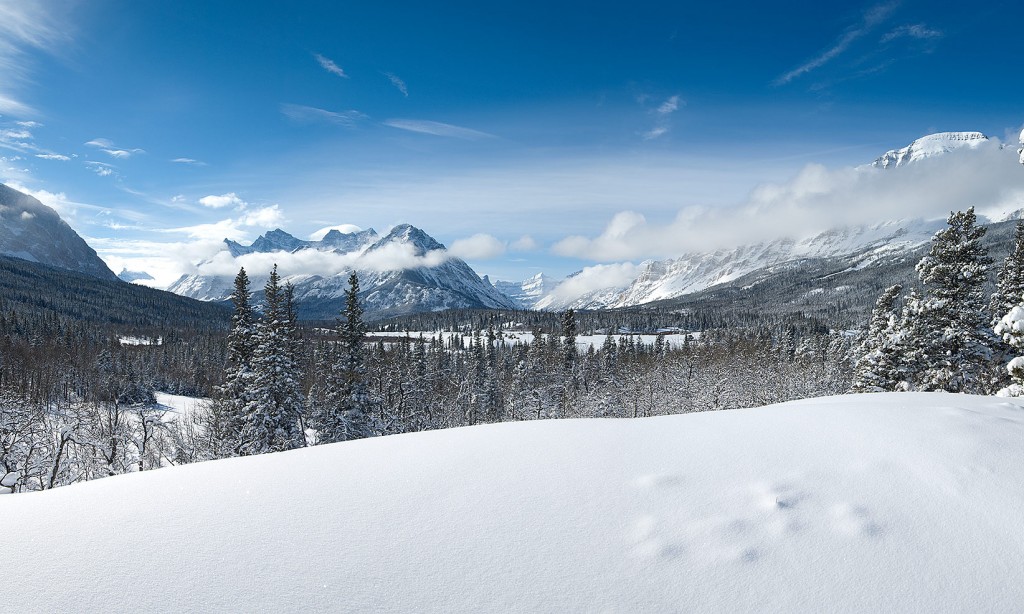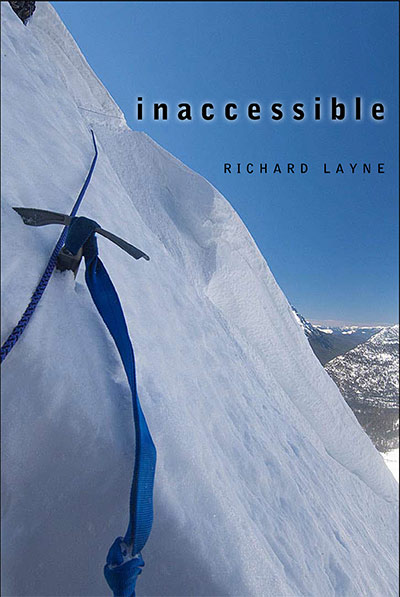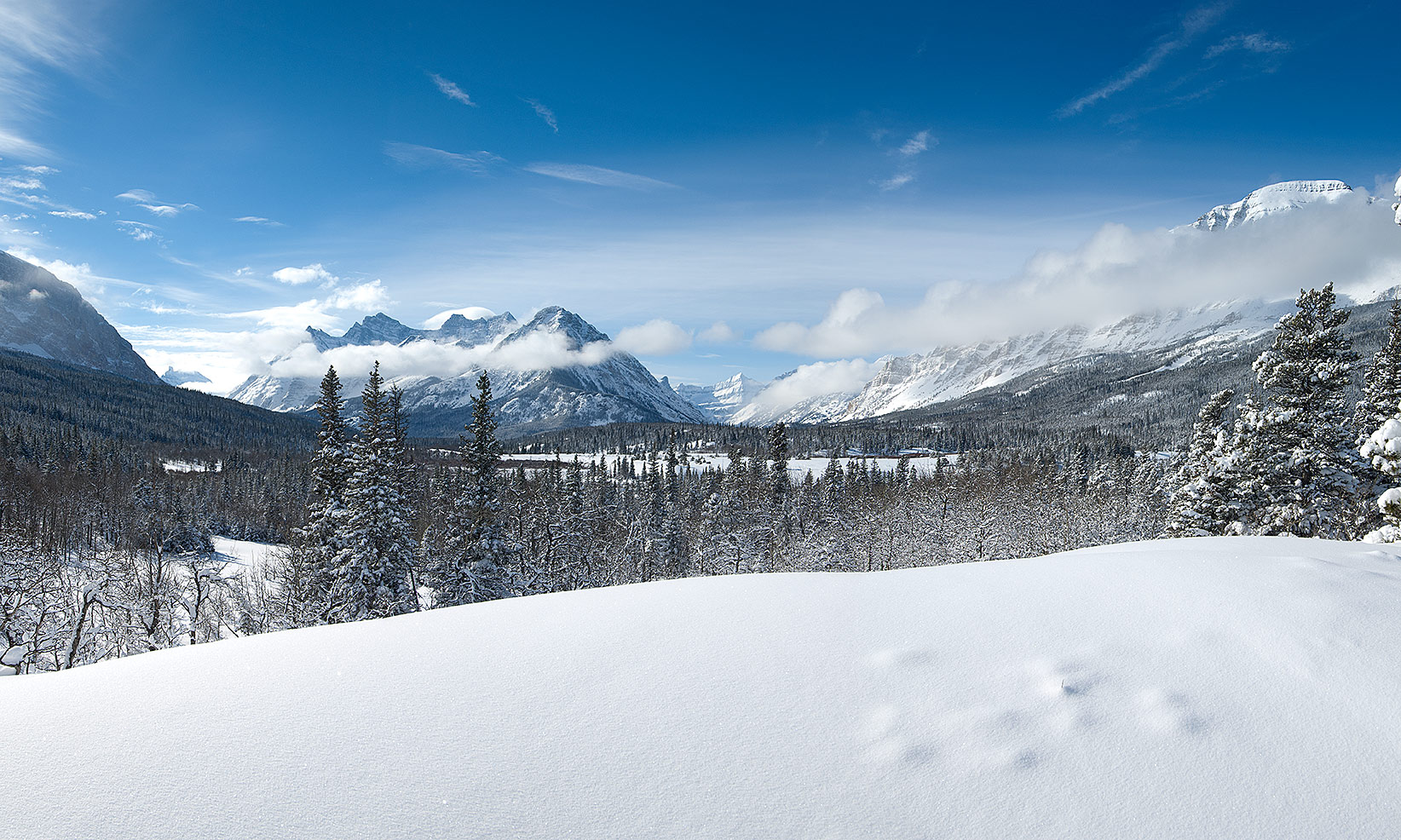
Chapter 4: The Snowstorm
February 5: The Storm

(Click on any photo to enlarge.)
I woke up hungry at 11 P.M. and ate a day’s ration of peanuts. I stayed awake for another three hours, and rose late at 7 A.M. Unaware of what had taken place overnight, as I prepared to light the stove I opened the top of the vestibule for venting. Snow spilled through the hole onto the stove, pillow, sleeping bag, and the back of my neck. I finally stopped cursing after I had a flame on the stove. With the coffeepot on, I opened the vestibule a little more and looked around. Three inches of snow had fallen.
After 21 hours in camp, it was noon when I left. In the continuing snowfall, I felt great, although I had reasons enough not to. As I began to trek up the nearly smothered trail I had packed the previous day, I realized I had been wrong about how much snow had fallen. There was closer to one foot of fresh powder. In the open areas, barely able to discern my one-foot-deep tracks of the day before, I needed an hour to travel the half-mile trail. At the top of a rare small climb in that area of the canyon, I dropped the backpack where yesterday’s packed trail ended and continued another two miles up the canyon, plowing through the powder like a young man. I turned around at a small stream a half mile short of Gable Campground and began the return trip to my backpack.
I had been packing trail for three hours, feeling strong. But before I reunited with my backpack, I ran out of steam. I pressed on, retrieving the backpack and soldiering down the trail again toward Gable Campground, but it was too much. Snow continued to fall, filling the day’s tracks. Doubting that my packed trail would exist the following morning, I nevertheless abandoned the last mile and made camp in an aspen grove near another nameless creek.

Inside the tent, I castigated myself for yet another low-mileage day and the entire trip’s travel. In five hours, this new camp was a mere one and a quarter miles beyond the previous night’s camp. Were my days of winter travel over? In four days, except for cinching the waist belt tighter, the end of each day felt the same. Granted, I was pushing through powder and carrying 90 pounds, but in my mind these were thin excuses for how little I was accomplishing. In particular, I focused on my age, which only fed my discouragement.
Throughout the night, I listened to the snowfall build up and slide off the tent. With the rising barometric pressure, eventually the storm would dissipate and the forecast temperature drop would happen. For tonight, though the snow buildup on the roof and sides of the tent kept the interior warm. I slept without my customary fleece cap and vest.
February 6: More Snowfall
After nine hours of sleep, I was up a little after 5 A.M. Like the day before, I had the normal two cups of coffee and hot stew breakfast while I took my time preparing for the day. The slower pace came from the increased soreness in my body. My knees were swollen and painful. The sciatic nerve in my hip was now troublesome not just on the trail but also in the tent and the sleeping bag. My shoulders hurt, and my hands would go numb if I kept my elbow bent for an extended period or while lying on either of my sides in the sleeping bag. When I laid flat on my back, the small of my back was increasingly painful.
The skin on my fingers was also splitting. Inconsequential the day before, overnight they had become painful. I had been applying barrier cream, but apparently not enough. Such skin splits are normal during winter trips. Skin is soft and pliable because of the moisture on the skin. In the low-humidity winter environment, this moisture evaporates rapidly off the skin, leaving it dry and brittle, opening the door for painful splits, which eventually bleed. The condition can become debilitating enough to be dangerous. Five years earlier inside this same canyon, my fingers became so sore I had trouble lighting a fire on the stove, tying my boots, and managing a host of other everyday tasks that required the use of my hands.

After finishing the coffee, I applied more Badger Healing Balm and did so again after washing the dishes. I also pulled on a pair of heavy-duty nitrile gloves. This recent addition to my backcountry winter gear had proved to be a vital one. Besides helping keep my skin from cracking, they had other uses. I could briefly hold hot containers, handle the camera and lens in subzero temperatures, dig around in the snow, or place my hands into a cold stream without the instant danger of frostbite. So far, in my experience they had but one downside in that my skin became too soft inside the gloves. Eventually they would also take on a repulsive odor. I could live with the smell, but injured hands were dangerous.
This was the fifth morning, turnaround day. I balked at the thought. I had packed a trail up the canyon more than one mile beyond this point, and goddamned if I would let it go to waste. However, on a hunch of where the day would actually go, instead of breaking camp, I shoved approximately 40 pounds of gear into the backpack and crawled out of the tent.
On the other side of the camp, the trail I worked so hard to engrave one and half feet deep into the snowpack the day before had disappeared beneath the overnight snowfall. Amazed and a little disgusted at the sight, I hefted the load and began pushing through the powder toward Gable Campground.
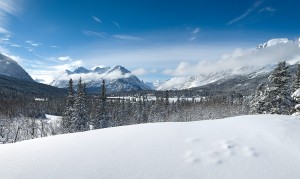
The barometric pressure had risen through the night, creating an apparent elevation drop of 235 feet. Through thinning clouds around the peaks to the west, I could see hints of blue sky. In the windless calm, the scene 300 feet from camp was breathtaking. I sacrificed some of my energy and ascended a treeless, 25-foot knoll on my left to photograph the canyon.

My feet were cold 20 minutes later when I dropped back down to where my trail once was. For 10 minutes, I struggled through deep powder. After 500 feet, I came to a gasping stop and asked myself why I was continuing up the canyon. With nearly two and a half feet of snow dropped in the last 36 hours, how would the exit be quicker than it took to get in? Obviously, I was going the wrong way. Beneath an increasingly open sky, I began to repack the trail down the canyon, bypassing my partially buried camp.
Almost four and a half hours after leaving camp, I noticed that the barometric pressure was falling again when I turned around at Threemile Campsite. I arrived back at my previous night’s camp six hours after leaving it. Tired, I was ready to quit. As I approached the tent, I boiled over in anger and snarled that I had now packed the trail three times in some areas of the canyon and was going to travel across some of the same ground six times. This trip had come straight off hell’s game board. Meanwhile, more goddamned snow was in the offing. The chill in the air was also indicative of a cold night ahead. I was asleep by 7:30 P.M.
Chapter 5: Arctic Cold Revisited
February 7: The Third Snow
Overnight, the temperature dropped below zero, compelling me to stay in the sleeping bag until 7:45 A.M., Much of the drinking water in the 96-ounce bladders froze despite their close proximity to my body. Although the barometric pressure was rising once again, when I looked outside I was discouraged to see that nearly another foot of snow had fallen overnight.
In addition to the normal morning activities, I spent the rest of the morning thawing equipment. As I took down the tent, I had to use a shovel to dig it out of the snow and ice. In the process, I accidentally scraped a pole sleeve on the side of the tent. That earned me a one-inch tear in the nearly new fabric. Then using the heat of my armpits, I thawed the frozen tent pole joints, which took time. Since it was too cold to stand still while thawing the poles, I paced and repacked the trail to the stream’s edge. I stayed warm, the poles finally came apart, and in the process, I re-created the nearly buried trail. The downside was that it took one and a half hours to break down and pack the tent.

By the time I was ready to go, the temperature was approximately 9 F. and it was 3 P.M. Several minutes later, I left the fresh trail and crossed the small stream. Actually, it was more of a barely controlled fall across the 6-foot-deep ravine. I slid down the bank easily enough, but the stream’s thin ice instantly broke beneath my snowshoes. I stepped quickly and scrambled up the other side of the ravine, which luckily enough was less steep. Somehow, I managed to avoid accumulating much slush and water. In the Arctic cold, ice-bound snowshoes would add more weight on my already taxed legs and feet and increased resistance as I plowed through the snow. I was fortunate to clamber out of the creek without a real dunking. A day earlier, I had crossed without any complications, but then my load had only been 40 pounds instead of nearly 90.

It came as no surprise that much of the trail from the day before no longer existed. A couple of times, I came close to dropping the backpack to repack the trail. In one open and nearly level quarter-mile leg through a meadow, I plowed through the powder for forty-five minutes, stopping every six to eight minutes. After two and a half hours and one and a quarter miles, I arrived at Threemile Campsite. Although I failed to grasp it on this day, a week later I would realize that, with increased endurance, this sixth day of travel was vastly better than the first few days.
With darkness less than an hour out, and the temperature dropping fast, I was careful, but quick to set up camp. Constant movement was crucial until I could get in the tent and fire-up the stove. In my last act before crawling into the tent, I filled two bladders of water at the nearby stream, which was rapidly freezing from the rocky bottom upward, an indication the temperature had gone subzero.
February 8: The Enemy of My Enemy
That night the Arctic cold came for a visit. I woke up several times and jogged inside my sleeping bag to warm myself. The failed sleeping system consisted of a down mummy sleeping bag with a rating of zero degree Fahrenheit stuffed inside a zippered fleece blanket. Both layers were inside a light bivy sack, and lay on two pads, which for their part kept the frozen ground from sucking the heat out of my body. Near midnight, I pulled on a fleece jacket and then added a lighter fleece vest. While the extra layers helped, I still had to jog in place several times until I got up at 6 A.M.

Although they lay next to my body through the night, the water bottle and bladders were frozen solid. That happened only when the temperature was colder than 20 degrees below zero. The cold had also affected the digital thermometer in my altimeter watch. The manufacturer boasted that the thermometer was accurate down to 19 degrees below zero, which explained the obviously wrong reading of 9 F. That also meant I did not know how cold it was. Real cold! I slipped the watch into a pants pocket and began the process of getting it warm, dry, and once again functioning accurately. I also decided that I had had enough. When I got back to civilization, I was going to buy a thermometer that gave indoor/outdoor readings simultaneously and was capable of accurately reading the temperature down to at least 40 degrees below zero.
There were two important functions in the watch for extended backcountry winter travel: an altimeter and a thermometer. The altimeter kept me informed of what sort of weather was coming, thereby giving me a chance to prepare or get out of the way. In a lesser role, and in conjunction with a topographic map and compass, the altimeter was also a navigation aid. Although the altimeter was more vital, it was still important to have an accurate temperature reading.
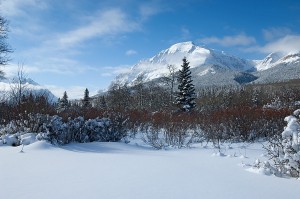
In light of how vulnerable this device was in winter conditions, I would have replaced it many years before. Except I had found nothing on the market that had all of the functions I wanted, including the ability to upload the daily logs onto the computer back in the office.
Like a day earlier, I walked down a nearly snow-filled trail while I thawed the tent poles in my armpits, except this morning took less time. That was probably attributable to only spending one night in this camp, thereby minimizing the moisture buildup. At 11:20 A.M., I hefted the backpack and continued down Belly River canyon. I traveled 150 feet to the end of the fresh trail and stopped. Unlike the day before there was now three days of snow on top of the trail I had laboriously packed earlier in the trip. Pushing through it with this load was out of the question. I dropped the backpack and was back to packing trail.
Because of the trouble with the watch earlier, with the exception of the thermometer, I quit watching for weather changes. Besides, I decided the cold was here to stay for a while. In the early part of the walk, the clouds still covered most of the sky, with many hovering on the higher peaks. They were also an indication of how fortunate I had been last night. With the clouds came lingering warmth, but that was about to change. In the first 25 minutes after leaving camp, the clouds dissipated and, for the first time since the trip’s first day, there was more sky than clouds. The sun eventually emerged, and within minutes the temperature rose enough that I began shedding layers of clothing.
Blue sky and snow—beautiful, yes, but also a reminder that I had been in this canyon before under similar conditions. Just eight days shy of five years ago, I nearly froze to death one interminable night here. The similarities brought the memory back fresh and raw. With that in mind, today I would put in an extra effort to get off the Belly River canyon floor. It would be better to be on the canyon wall rather than down here when the real cold arrived this evening.
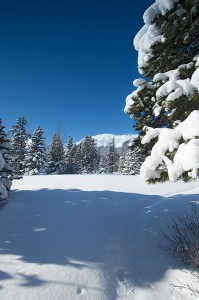
Half an hour later, I was a quarter mile short of beginning the climb when I entered an open flat near a bend in the Belly River. Surrounded by scattered limber, Douglas-fir, and cottonwood trees, the small meadow was a white paradise. With the additional asset of the open water of the river, it was also a nice place to set up a camp. As I continued on, I was unaware that the elevation on the altimeter read 4,396 feet (a fact I would later discover back at my office going over the trip log). I began the climb 15 minutes later.
For another hour and fifteen minutes, I pushed through deep powder until I was too tired to continue. With 400 feet ascended, I was over half way to the parking lot. In light of what kept happening, I had some misgivings about having made the trail so lengthy. The past five days had shown my exertions would be a waste if I did not use the trail the day I packed it. Nevertheless, I justified my actions with the high barometric pressure indicated by the calm and now nearly cloudless sky. All that was coming for at least the next 24 hours was a whole lot of cold.
I was back at the flat next to Belly River in 45 minutes. Tired from the exertions of pushing through the powder while ascending, I decided to use the meadow for the next camp. I packed a path to the river’s edge for access to water and stomped a campsite 200 feet away. Soon finished, all I needed to do was travel one mile and retrieve the backpack, return and erect the tent, and then get everything inside. In my exhaustion, the task looked daunting. I had also missed that in two and a half hours, according to my altimeter, my location had gained another 45 feet of elevation.
When I arrived at the backpack, the last of the clouds had finally dispersed. I was now certain the coldest temperatures of the trip would arrive tonight. As I pushed toward the camp, the memories of my efforts to get out of this canyon in February 2006 flooded my thoughts. Punctuated by hunger and exhaustion, I broke down, afraid I was about to experience a repeat or worse. I wiped my eyes without stopping.

Arriving at the new campsite, I kept moving. Too tired to notice my altimeter readings, the elevation had increased another 30 feet at this spot in the last hour and a half. An hour later, with two freshly filled water bladders, I threw the last of the gear into the tent. A few minutes earlier, at 5:30 P.M. the sun had disappeared behind Glacier’s peaks and the temperature immediately dropped below zero.
Although the 2006 experience had better prepared me, I was unable to convince myself that this was going to be anything less than a repeat of that near-death nightmare, particularly after what had happened the previous night. In the tent, I hustled with the necessary prep of getting the gear stowed and dinner cooked. At 7:45 P.M., as I settled into the sleeping bag the fear bubbled over again and the tears returned, but only briefly. Exhaustion and a full stomach soon put me to sleep. For the next four hours, with the piercing cold biting at my cheeks and lips, I woke at least once every hour and jogged in my sleeping bag. After midnight, I awoke with a need to go to the toilet. For that, I had a sealable freezer bag, except the only way I could use it was to open the sleeping bag.

Several minutes later and buried again in the bag with the lost heat rekindled, I quit jogging. In the sudden quiet, for a moment I thought I heard a familiar whisper in the distance. Wondering if I just imagined what I heard, I stayed quiet and listened. Several seconds later, I heard the sound again, this time much closer and convincing. Somewhere out there a wind was pushing through the trees! Shocked, I wondered how that could be. Then I realized I had not kept up with the altimeter since I woke up the morning before. The wind meant that the barometric pressure was dropping again—warmth! Shaking off the mistake of negligence, with rising hope, I wondered if it would drop into the canyon and blow out some of this awful cold.
Less than a minute later, I had an answer. The gust arrived in the branches of the sparsely populated trees around the camp and broadsided the tent. When a shelter shook that hard, it was reasonable to be worried. Tonight though, I breathed a sigh of relief and thanked the powers that be for the wind, as indeed the enemy of my enemy became my friend. Within a few minutes, my face, feet, and torso were warm. I checked the thermometer. The reading was 18 F. More than an hour later, my excitement subsided and in spite of the noisy flapping of the tent shell, I fell asleep.
February 9: The Harshest Days
Although it was too soon to complain about my newfound friend, the gusting wind woke me throughout the remainder of the night. When I awoke at 5 A.M., I knew it was time to get up. Nevertheless, being toasty warm and comfortable I lay my head back for just a few more moments.
The next time I woke was at 8:15 A.M. Shocked, I got going quickly. Nor was I doomed to get comfortable anytime soon. I was preparing to light the stove when I realized going outside was going to have to happen immediately. It had been 48 hours since my last bodily evacuation, and my digestive system made it clear that this was as long as it would go. The need came on so quickly I vacated the tent with only wool socks on to protect my feet. To make matters worse the wet flushable wipes were frozen.
This was one of those rare moments I was glad to be alone. Back inside the tent, my imagination promptly conjured up the nightmarish scene another person would have been stuck with that morning inside the tent as I thawed the wet wipes.
Although unsure how low the temperature had dropped the night before, the one-quart saucepan of water was frozen solid, as were the two water bladders and 16-ounce water bottle. Except for the saucepan, all the other items had spent the night against my body and covered by a coat. Rarely did I see that happen. It was obvious that the temperature had dropped beyond 20 degrees below zero again. That also meant that when the wind arrived, the temperature had jumped nearly 40 degrees.
Many years before, I had learned to have a full pan of water ready to thaw on the stove. After melting the ice, I could then go through the process of thawing the bladders and bottle in the hot water of the saucepan. If I was unable to thaw the bladders, the only recourse would be to carry the full, frozen bladders in an already monstrously heavy backpack. Today, I had plenty of fuel. On the much longer planned crossing of Glacier, however, with fuel at a premium, the added weight of full, frozen bladders could prove disastrous.
Finally comforted by the first cup of steaming coffee, I reflected back on what I had seen while outside. The wind had done its work. Besides the nearly snowless trees, sections of the trail leading out of camp no longer existed. Where the trail penetrated the cottonwood tree grove 200 feet away, the deep groove of the trail partly reappeared. Perhaps fate had given me a break and left portions of yesterday’s packed trail unfilled.
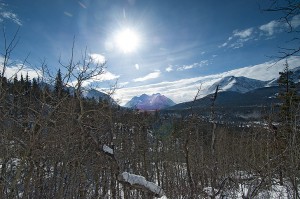
By midmorning, I realized that my lateness in rising, thawing the frozen bladders, and having at least a partially filled trail meant that the soonest I would make it back to the van on the highway was the next day. Breaking camp and preparing for the day ahead in winter conditions generally required four hours. On this day, the travel began at 12:45 P.M.
With a nonstop wind interspersed with gusts, my new friend from the night before soon fell off its pedestal. In one hour, I ascended a mere 200 feet up the wall. Half an hour later, I stopped in a small clearing to catch my breath. The gusts slammed into me so hard I had trouble standing. I turned to face the wind, and saw a repeated scene from the second day; a storm that Glacier’s peaks seemed to be holding back from clobbering me. Inspired by their protectiveness, I kept going.

Two hours after leaving camp, I was 400 feet into the ascent with the end of yesterday’s trail just behind me. I dropped the backpack and went back to packing trail, climbing for 15 minutes before turning back. By the time I got back to the backpack, drifting snow in the numerous open areas had buried much of the freshly made trail. When I arrived at the upper end of the fresh trail with the backpack, a total of 45 minutes had passed, while only rewarding me with 100 feet of ascent.

I dropped the backpack three more times, having learned to travel a maximum of 10 minutes before turning back. The three feet of new snowfall over a 72-hour period was now drifting. The consistency of the snow was also changing; it was thicker and far more difficult to push through. By 4:30 P.M., I was more exhausted than at any other time in the eight days I had been messing around with this damned canyon.
A few hours earlier, I had surmised I would probably spend one more night in Belly River canyon, albeit on the wall. When I finally staggered to a halt too tired to go any further, the sun was setting. I was also back in the Douglas-fir and lodgepole forest, which meant the road was close. In five hours, according to my map and altimeter, I had ascended only 600 feet and traveled less than a mile and a half. (Wrong yet again, I had failed to account for the changing barometric pressure when calculating my travel. I had underestimated by 100 feet in elevation and a half-mile in distance. Given the adverse conditions, the discrepancies were huge.)
The fatigue was so great that all I wanted to do was crawl into the sleeping bag and go to sleep. Instead, I cooked the stew and forced myself to eat. The food eaten this evening was going to affect how well I would do the next day. I was asleep by 8:30 P.M.
February 10: Old Man Muscles
I woke up at 3 A.M. hungry, so out came a bag of peanuts. I was soon back to sleep, but arose for the day at 5 A.M. Just over four hours later, with the temperature a warm 23 F., I was packed and ready to continue up the trail. Rather than hefting the load, I began to pack the trail from the edge of camp.
Half a dozen steps later, I noticed the tiredness from the day before was still in my leg and buttock muscles. My body was still recovering in spite of 12 hours in camp and 8 hours of sleep. I figured I knew what was wrong. Yesterday’s harshness combined with the lack of enough food or water would now affect today’s travel. The forced eating before going to sleep had fallen way short of what I needed. Nor were the peanuts in the middle of the night going to offset the punishing activity of the day before. Couple all that with what I had taken to calling “old man muscles,” and this morning’s weakness was explained. No matter, I still had to push on as far as I could with what I had. In 15 minutes of travel, I found out I had spent the night only a fifth of a mile and 80 feet below the snow-covered parking lot at the Chief Mountain Customs Station.
As far as I am concerned, there are two types of powder snow. The first is what initially falls out of the sky. Get enough of this, and I did, and it becomes difficult to travel through. The second type is nothing more than a slight metamorphosis of the first, but it’s far more difficult to travel through. Subfreezing temperatures combined with a whole lot of wind are the two necessary ingredients to create the change. All those gorgeous snowflakes blow about and slam into each other, breaking down into something similar to ugly-clingy powder. They cling to each other creating a crust, of sorts, on the surface.

This crust is different from the solid surface created by the seesaw affects of warm and cold temperatures. Like a properly prepared and baked piecrust, under the slightest pressure this wind crust will crumble. That is when the snowshoe will drop through into the powder beneath. Since the snowshoe is normally moving forward when the crust breaks, snow piles up on top of the front of the snowshoe, weighing it down. In deeper snow, I tend to stop with every other step and shake the snow off before taking another step. When the snowshoe drops down less than a foot however, I just barge through. Except that weak excuse for a crust then has to be broken through from the bottom upward. This slower travel is maddening and quickly exhausting. I soon found that the Chief Mountain parking lot and highway were awash in wind crust.

I dropped the backpack on the road and continued to plow up it. Over the next three hours, I dropped the load three more times and ascended 160 feet before arriving on top of the ridge with the backpack, a mere three quarters of a mile south of the customs station. Exhausted, I would go no further that day. Tremendously disappointed that I would need yet another day to arrive at the vehicle, at 2:50 P.M., I trudged another 400 yards and built camp in the lodgepole forest on a knoll 50 feet east of the road.
Inside the tent, I did what I could to undo the damages of the day. While traveling, I had continued to stuff snow into the 16-ounce water bottle and then kept it inside my shirt and against my chest to keep the snow melting. Nevertheless, I was unable to stay hydrated. Inside the tent, within a short time the dehydration cramps attacked again.
Today in less than five hours, I was all in. My travel for the day was less than one and a half miles of forward progress, an average of one-quarter mile per hour. With over two miles and two valleys still in front of me, based on today’s travel I would need six hours to get back to the trailhead. The thought revolted me, and the resultant discouragement was overwhelming. How in the hell did I get so old so fast? Was it even possible to get into good enough shape to access Hole in the Wall, much less attempt crossing the entirety of Glacier in winter? On this evening, I was doubtful.

Although I had food and fuel for another three days, I would be officially overdue as of tomorrow. Carleen, already worried, would hold off for another 48 hours before she made the call to the park service.
Lots of sleep was crucial, but so was the water and nourishment. I started slugging down food immediately, melting snow, and drinking large quantities of water. All right, I had old man muscles and was out of shape. Was it also necessary to starve and dehydrate them?
Although tired, I had trouble sleeping. Each time I woke, as if I was in an echo chamber, the voice in my head informed me that I was too old and out of shape to continue such trips.
Chapter 6: Exit From Belly River Canyon
February 11: Fresh Resolve
I arose before 5 A.M. Once a hot cup of coffee was warming my hands, my situation stopped looking so bad. My thoughts of quitting disappeared. Okay, I’m no spring chicken. But I’d be damned if I would lay a weary arm on that coffin 20 or 30 years early.
I also had a plan. Yesterday’s mistakes could create a different set of tracks for today. More than the full water bottle, there would also be a partial bladder for the trail. Each time I dropped the backpack or picked it up while packing trail, I would suck a couple mouthfuls out of the extra water. For nourishment, the fruit and peanuts were still there. In addition, I still had three and a half English muffins, which I was going to slather with the remaining peanut butter. Combined, the muffins and peanut butter would provide me with an extra 1,600 calories. Old age might pull me down before I arrived at the van, but I would do everything I could to make sure my body had plenty of water and food.

With a mild temperature of 30 F. and shortly after 9 A.M., I stepped back onto the road. I was delighted to see that most of the trail that I had packed the afternoon before toward Lee Creek Bridge still existed. Nevertheless, the easy travel ended 20 minutes later where the trail ended. With the backpack still on, I tried punching through the wind-packed snow as I continued the one and a quarter miles and 328-foot elevation loss to the bridge. I made it only a few feet, dropped the load, and returned to packing the trail through the powder.
At 43 minutes, I was 300 feet short of Lee Creek Bridge. I had planned to turn around at the bridge, but the wind had swept much of the snowpack off the road here. When I got back to the backpack, I stuck to the plan and pulled out the water and sandwiches. I hefted the load 20 minutes later and arrived at the end of the trail half an hour later. I had needed two hours to get the backpack here. As discouraging as that should have been, my spirits were up.
With plenty of energy still in me, I now walked with the load rather than first packing a trail. Unsure of how far I would go before I dropped the load again, every little bit of forward progress I made without traveling over the same ground three times was a tremendous relief. On the south side of the bridge, I spotted my tracks from 10 days before. Once again, in deep snow, I traveled on top of the windswept and crusted tracks.
Around the curve beyond the bridge, I spotted the first two of four cross-country skiers as they popped up over the next ridge approximately a fifth of a mile away. Relieved to see other people for the first time in 10 days, a couple minutes later we halted in front of each other. As it turned out, they were traveling to Belly River Ranger Station. All were young summer employees of the park, presently laid off and performing volunteer work in wolverine studies. A friendly lot, the one woman in the group thanked me for the trail from the gate on the highway to this spot. I bantered with them about that for a minute, letting them know my preference was to have had it the other way around for the last several days. Hearing my description of how I packed the trail for most of the trip, there was a momentary stirring as they glanced at each other.
The elder of these young travelers and possibly the one in charge, was David Smith, a strapping 30 year old. Three and a half months later, I would see him again under very different circumstances.
They had recently gone to Glacier’s Goat Haunt Ranger Station via Waterton Townsite in Canada for the same reason as this trip. Besides finding their actions admirable, I had an additional interest in where they had been. I listened to them talk about taking a single day to arrive at Goat Haunt from Waterton Townsite. Encouraged, I once again got back to thinking about crossing Glacier rather than the last 10 days of getting my butt kicked.

I hiked the final one and a quarter miles in 75 minutes. When I arrived at the gate blocking the road, standing on a snowdrift, I threw my right leg over the metal bar of the gate, and then with a sigh of relief plopped my body and backpack onto it. For several seconds I thought I was going to take a break before completing the final 50 feet to the van. Like so much of the trip, being wrong would continue on this side of the gate as well. A gust slammed into the load and me. A moment later, I was lying prone in the snowpack on the other side of the gate, and the trip was over.
Officer Jeremy Kelly of Homeland Security (Border Patrol) was in his patrol vehicle waiting for me. At least I like to think that was what he was doing. We grinned at each other as we met up.
I first met this man five years earlier. When I had exited the park at the end of my second trip in 2006, the temperature was 15 degrees below zero at the closed gate. As it turned out, he had been sitting there for the last three afternoons and into the evening waiting for me to exit. Two days before that, while crossing the river near Belly River Ranger Station, I had broken through the ice. Suddenly I had found myself fighting for my life in subzero temperatures. Then the night before I exited, with a broken stove and damp sleeping bag, I thought I was going to die when the temperature plummeted to near 40 degrees below zero. At the time, what I had just gone through was unknown to him, although in those frigid conditions he correctly figured I had had a tough go of it. When I heard what he had been doing, I had broken into tears. As a result, since the early evening of February 17, 2006, the Border Patrol/Homeland Security has been on my good guy list.
As I got out of the trail gear and retrieved the lighter clothing and footwear for some civilized comfort, I talked about this trip and the trips planned for later this winter. When I got to the part where I would cross the international border into Canada to resupply, Officer Kelly took issue with the plan. He thought it would be a good idea to have an alternative route without a border crossing, and to use it. He was very clear in his statement that if I crossed the border, I would have trouble with both Homeland Security and the Royal Canadian Mounted Police.
Although I said nothing, I immediately thought about those four young and unemployed people who crossed the closed border a few weeks before. It has always been my impression that outside of an emergency, the laws extend to all in an equal manner.
Kelly’s information was discouraging. In front of me were at least two more trips before taking on the challenge of crossing Glacier, all of which might already be impossible. Now I faced getting in trouble with American and Canadian authorities. The new information increased the already problematic logistics and peril, but until I came up with an alternative, I would continue to plan the crossing.
Summary of the Trip
I later found out that during the cold spell, the Many Glacier SNOTEL site in Glacier recorded a low of 27 degrees below zero, while Hudson Bay Ranger Station recorded 30 degrees below zero. In a nonsensical way, where the failure of the sleeping system was concerned, the information made me feel better.
Back in Helena, I had trouble reconciling the trip. There was no doubt the effects of getting old would continue. Was I already too old for these types of trips? While some people clearly thought so, I was unsure. The next trip might provide an answer, although I would return only after a crust had formed on the snowpack.
There were also some other issues from the trip that I needed to put to rest. I began the trip weighing 206 pounds, approximately 30 pounds overweight. The backpack had weighed over 90 pounds. Additionally, from the gate the snowpack had been tough to get through, while the three feet of fresh powder that fell during the trip increased the difficulty. I finally concluded that carrying that much weight on a crust-less snowpack would probably have slapped anyone silly. Even Joe Cosley, from more than 80 years before and known for his extraordinary feats of snowshoe travel, had expressed some reluctance about traveling in the powder of Belly River canyon. (For more on Cosley, see Belly River’s Famous Joe Cosley, by Brian McClung, Life Preservers Publishing, 2009.)
I concluded the condition of the snowpack was the major reason for the difficulty of the trip. Since I would be waiting for a strong crust to form on the snowpack before I returned, any difficulty in the next trips would have to come from a different direction. As it turned out, that is precisely what would happen.

